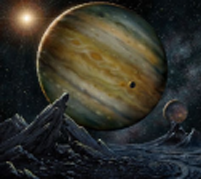 In the 1990's, astronomers discovered the first planets outside the solar system. Since then, in what has become a torrent, more than 360 planets have been found, and the pace of discovery is quickening. Mostly giant planets similar to Jupiter, or ice giants similar to Neptune, these worlds occupy orbits that are often bizarre. More than 50 of these "new" planets are ~100 times closer to their parent stars than Jupiter is to the Sun (~20 times closer than is Earth). They are roasting in extreme proximity to stellar fires, and many are observed in transit across the stellar disk. Some are in wildly eccentric orbits, many reside in multiple planet systems, and some of the most recently discovered have masses and radii in the terrestrial (Earth) planet range. Clearly, these extrasolar systems of planets are very different from the straighforward extrapolations of the solar system mankind has been studying for millenia.
In the 1990's, astronomers discovered the first planets outside the solar system. Since then, in what has become a torrent, more than 360 planets have been found, and the pace of discovery is quickening. Mostly giant planets similar to Jupiter, or ice giants similar to Neptune, these worlds occupy orbits that are often bizarre. More than 50 of these "new" planets are ~100 times closer to their parent stars than Jupiter is to the Sun (~20 times closer than is Earth). They are roasting in extreme proximity to stellar fires, and many are observed in transit across the stellar disk. Some are in wildly eccentric orbits, many reside in multiple planet systems, and some of the most recently discovered have masses and radii in the terrestrial (Earth) planet range. Clearly, these extrasolar systems of planets are very different from the straighforward extrapolations of the solar system mankind has been studying for millenia.
Excitingly, the study of exoplanets is emerging as a central focus of an increasing fraction of the world's astronomers and planetary scientists and is galvanizing a new generation to embark upon paths of discovery and characterization. This conference brings together scientists at the interface between stellar and planetary science who will report on the exciting recent developments and future directions at the frontiers of this exploding field.
Geared toward secondary school physics teachers in the U.S. KITP is eager to include teachers from population groups under-represented in physics.
Adam Burrows, Princeton University, coordinator of the conference
